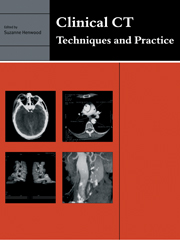CHAPTER 4 - The Thorax
Published online by Cambridge University Press: 16 March 2010
Summary
Introduction
Cross-sectional imaging of the thorax using computed tomography provides a simple, non-invasive demonstration of all structures of the thorax. It can often identify confusing superimposed shadows seen on the plain film chest radiograph. It is recognised primarily as an accepted technique to provide diagnosis, differentiation and staging of the course of pulmonary or mediastinal disease.
CT imaging techniques and identification of attenuation values may determine diagnosis, while CT guidance is widely used for intervention – biopsy, aspiration or drainage. In the staging of malignant disease CT provides important information for the surgeon and oncologist, and CT is routinely used in the planning of radiotherapy treatment.
General note – CT scanning of the thorax is not usually performed in isolation. Other investigations and/or imaging modalities may be required to complement or supplement the information obtained. Other areas may need to be scanned, to look for source or spread of disease or extent of trauma. Protocols for such scanning are discussed elsewhere.
Helical versus conventional CT
The advent of helical CT scanning has greatly increased the potential of CT imaging of the thorax. Short acquisition times, utilising a combination of slip-ring technology, patient translation, movement reduction algorithms, higher powered X-ray tubes with rapid heat dissipation and more efficient X-ray detectors, allow the entire thorax to be imaged in a matter of seconds. Most importantly this usually means within a single breath-hold.
CT imaging of the thorax may necessitate demonstration of the bony thoracic cage and the soft tissue structures within, in their entirety, or it may focus on a particular organ or pathology.
- Type
- Chapter
- Information
- Clinical CTTechniques and Practice, pp. 47 - 68Publisher: Cambridge University PressPrint publication year: 1999



